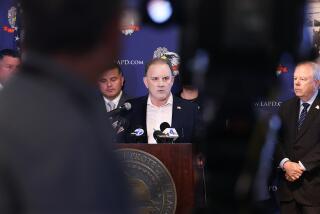Video spurs Bratton to weigh review of pepper-spray policy
LAPD Chief William J. Bratton said Tuesday that he was concerned when he saw a videotape showing an officer using pepper spray on a handcuffed suspect in the back of a patrol car and that he is considering a review of the policy governing when officers can use the spray.
Bratton said the tape, shot in 2005 on the Venice boardwalk and made public Monday, concerned him enough when he saw it last year that he immediately removed the officers involved from active duty pending an internal investigation. The officer who used the pepper spray has left the department, but an investigation is continuing, Bratton said.
The chief said the videotaped incident âmay look awful,â but he added that the Los Angeles County district attorneyâs office found no crime committed by the three officers involved in the Venice Beach arrest in their treatment of the suspect.
Still, Bratton said his own administrative decision on whether they complied with department policy is still days away.
The chief said he was uneasy that the officer shut the door of the patrol car, leaving the handcuffed suspect alone inside, after administering the pepper spray.
The closing of the door âwas one of the reasons I had concern,â Bratton said.
âMy interest there is: Was that pepper spray used to control the behavior of that individual or was it used punitively?â he said.
âIf in my judgment the individual ceased to be a threat to the officer and other tactics could have been used, then I could conceivably find the officer out of policy. That whole case really comes down to that issue. And also the closing of the door.â
Brattonâs comments come as some police watchdog groups and the American Civil Liberties Union called Tuesday on the LAPD to reexamine when officers can use pepper spray, particularly if suspects are handcuffed. Current rules allow the spray to be used whenever a suspect is âcombative,â but some say that definition is far too broad.
âItâs appalling,â Catherine Lhamon, an attorney for the ACLU of Southern California, said of the Venice incident. âThere is no question that spitting on an officer does not merit pepper-spraying someone when they are handcuffed in the back of a patrol car.â
Bratton said he is considering an examination of when officers should use the spray.
âThis would not be too onerous a burden for the department to engage in that review,â he said.
Members of the Los Angeles Police Commission, meanwhile, ordered the inspector general to launch an assessment of how the LAPD handled the Venice incident.
âIt is a disturbing tape,â Police Commissioner Andrea Sheridan Ordin said. âI ask that these matters be given the highest priority so we can assure ourselves and the public about what has occurred.â
Ordin said the evaluation by Inspector General Andre Birotte Jr. might raise questions about the policy allowing officers wide discretion in the use of pepper spray on handcuffed suspects if they are judged to be combative. But she and others said it was premature to consider policy changes yet.
The videotape was played for The Times on Monday by an attorney who represented the defendant, identified in police reports as Benjamin Barker.
Barker, a transient, was arrested after getting into a scuffle with a merchant on the boardwalk.
He pleaded guilty to misdemeanor battery on the shopkeeper.
The videotape shows Barker in handcuffs as he is bent over a patrol car. As the officer pushes him into the car, Barker can be heard saying, âWhy am I going to jail?â
Once Barker is in the back seat, he starts shouting: âI canât breathe! I canât breathe! Donât spray me!â
One officer is heard saying: âHe knows whatâs happening.â
Another officer takes a pepper-spray canister from his belt, shakes it and leans in to apply it to Barkerâs face.
The officer closes the doors of the patrol car and steps back. Barker is seen holding his face up to the car window, his features contorted in pain.
The district attorneyâs investigation looked at whether there was enough evidence to show that the officers had committed a crime against Barker. The LAPD inquiry is looking at whether the officers violated department policies.
The closing memo from the district attorney, released Tuesday by Bratton, said the officer and two colleagues âdid not use excessive forceâ and instead âshowed remarkable restraint and demonstrated professional courtesy toward Barker despite his belligerent, threatening and combative behavior.â
The officers involved told authorities that Barker spat on one of them and was threatening to spit again when he was pepper-sprayed.
Bratton acknowledged discrepancies between the police reports and the videotape.
Two officers said in initial reports that the spitting and use of pepper spray occurred outside the car, but the video shows that the pepper spray was used in the car.
The district attorneyâs office dismissed the disparity, which was corrected in a follow-up police report, as âa product of mistaken recollection and not intentional misstatements of material fact,â the closing memo said.
The Venice incident comes as the LAPD and FBI have begun investigations into another videotape showing a police officer hitting a suspect in the face several times at the end of a foot chase in Hollywood.
Police union President Bob Baker issued a statement Tuesday urging the public to be understanding of the job that officers face.
âAsking officers to refrain from using approved tools or techniques in their arrests is akin to telling the soldiers in Iraq to just reason with the insurgents,â Baker said. âPerhaps the activists would like to talk to the families of the LAPD officers who have been maimed or killed when some thug who was resisting arrest decided to shoot the arresting officer because he didnât feel like going to jail that day.â
Councilman Bernard C. Parks was among those who called on the commission to deal more effectively with the latest allegations of excessive force.
Parks, a former police chief, said the LAPD has, for more than a year, ignored his warnings about âthe ongoing discipline problemâ in the department.
âNow, after last weekâs release of the videotaped LAPD beating of William Cardenas, we are left to try to close the barn door after the horses have already left,â Parks wrote. âIn trying to find a resolution to the problem that we knew existed more than a year ago, I again ask the commission to get to the bottom of the issue.â
Parks said the commission should look at complaints and dispositions from the five years before Bratton became chief compared with those from the time since Bratton has headed the department, arguing that a ârelatively low number of employeesâ have been disciplined in the last three years.
The councilman also called on the commission to reconsider the policy of concealing officersâ identities in reports on officer-involved shootings and Boards of Rights investigations.
âThe decision to shut the public out of these two processes goes against preserving the idea of transparency at the department,â Parks wrote.
Later in the day, the head of the councilâs Public Safety Committee called a public hearing for Monday to examine whether a proposal to install video cameras in police cars might provide the public with better information on controversial incidents than it gets from bystanders using camera phones.
âIn light of these YouTube beatings, the public needs to know there is a public policy solution here, which is rapidly installing video cameras in cop cars,â said Councilman Jack Weiss, the chairman.
Even if the car cameras do not capture video of an incident, microphones that pick up sound several hundred feet away might capture audio that can put a use-of-force incident into context, Weiss said.
He added that the images in the latest videotapes may be disturbing but that he trusts the LAPD to fully investigate any use of force and that some force may be justified.
âI donât know where people got the idea that you could ever have a Police Department without violence,â Weiss said.
*
More to Read
Sign up for Essential California
The most important California stories and recommendations in your inbox every morning.
You may occasionally receive promotional content from the Los Angeles Times.











